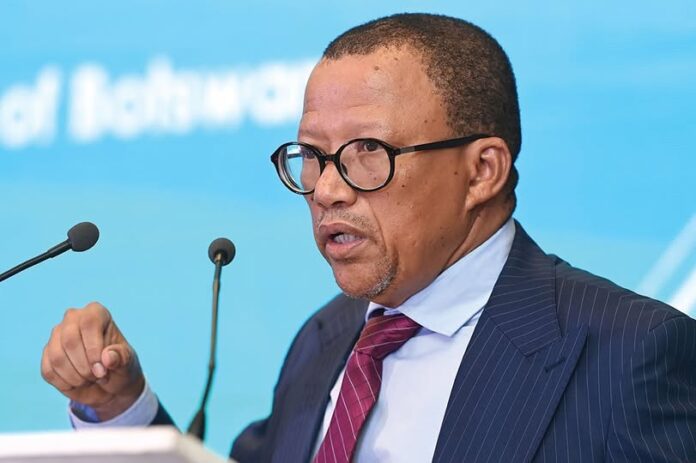19th February 2025
Own Correspondent
The Monetary Policy Committee (MPC) of the Bank of Botswana has determined to maintain the Monetary Policy Rate (MoPR) at 1.9 percent.
In addition, the Bank reduced the Primary Reserve Requirement (PRR) from 2.5 percent to zero in December 2024. This change was done to address the persistent shortage in liquidity experienced by commercial banks in the fourth quarter of 2024. The liquidity injection was to allow commercial banks to perform their intermediation role to support economic activity.
As reported by Statistics Botswana, real gross domestic product (GDP) declined by 4.3 percent in the third quarter of 2024, compared to a growth of 1.1 percent in the corresponding quarter in 2023.
“This marks the third consecutive decline in GDP, following contractions of 5.2 percent and 0.4 percent in the first and second quarters of 2024, respectively, indicating that the economy is in a recession. The contraction in economic activity is mainly attributable to the decline in diamond mining output and revenues,” said Cornelius Karlens Dekop, Govenor of the Bank of Botswana.
He said, “This contraction is further compounded by the weaker performance in non-mining sectors. As a result, export earnings declined, constraining government spending and dampening overall economic activity in the second half of 2024.”
Botswana’s real GDP is projected to expand by 3.3 percent in 2025, from an estimated contraction of 3.1 percent in 2024.
It is anticipated that recovery in the mining sector and effective implementation of the economic transformation reforms supporting economic activity by facilitating expansion of productive capacity, accelerating economic transformation and enhancing economic resilience will grow economic activity modestly.
Monetary policy also remains largely accommodative, given the projections for low inflation into the medium term, therefore, conducive for financing of economic activity.
The global economic growth is expected to remain subdued at 3.3 percent in 2025, slightly higher than 3.2 percent in 2024. This is against the backdrop of cuts in production and shipping of commodities, civil unrest and conflicts, extreme weather conditions and low underlying productivity.
Regarding price developments, global inflation is projected to moderate further in 2025, reflecting the slower pace of monetary policy easing implemented in 2024, which kept interest rates at relatively high levels, as well as the anticipated lower food and oil prices.
Inflation is forecast to remain below the lower bound of the 3– 6 percent objective range in the short term but is expected to revert to the objective range from the second quarter of 2025.
“It is notable, in this regard, through the December 2024 Business Expectations Survey, that the business community expected inflation to remain within the Bank’s objective range in 2025, implying that inflation expectations are well anchored,” said Dekop.
Inflation is forecast to be within the medium-term objective range and inflation expectations are well anchored. Moreover, the recent and prospective developments for both domestic and external economic activity suggest that the economy will operate below capacity in the short term. If this situation persists, then it may allow for accommodative monetary policy in 2025.
It is expected that inflation in Botswana would be, on average, 1.5 percent higher than in the trading partner countries, suggesting maintenance of a downward rate of crawl of 1.51 percent for 2025. In addition, the Pula basket weights were adjusted from 45 percent South African rand and 55 percent for the SDR to equal weights of 50 percent.
“This adjustment is expected to moderate the volatility of the Pula against the South African rand and enhance the competitiveness of Botswana’s goods and services in the South African market, which remains a key trading partner,” said Dekop.
Domestic inflation hovered around the lower bound of the medium-term objective range of 3 – 6 percent, before breaching the lower bound for successive months from September 2024, and averaged 2.8 percent in 2024, significantly lower than 5.2 percent in 2023.
The low inflation environment in 2024 was against the background of subdued domestic demand, the absence of significant upward adjustments in domestic fuel prices compared to 2023, impact of the reduction in domestic fuel prices, the decrease in trading partner countries’ inflation, higher appreciation of the Pula against the South African rand and the restrained growth in food prices.
The domestic economy is estimated to have contracted by 3.1 percent in 2024, a marked slowdown from the 3.2 percent growth in 2023. This contraction is mainly due to significant declines in the mining sector and deceleration in non-mining output growth.
Dekop, said “The contraction in mining growth is mainly due to a combination of external factors, such as subdued global demand, the growing popularity of other luxurious goods in major markets, global economic uncertainty and geopolitical conflicts.”
Meanwhile, the deceleration in non-mining growth was mainly due to contraction in the output of the diamond traders and manufacturing sectors.
Weak economic activity in the non-mining sector could also be attributable to the slow and limited impact of the various economic transformation initiatives, continuance of low productivity and drought conditions, as well as challenges associated with limited fiscal space.









